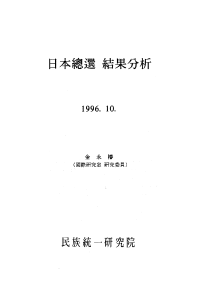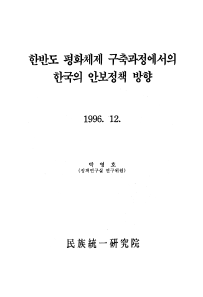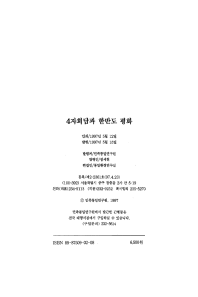
연구원발간물Study Series 2012-03
Basic Reading on Korean Unification
- 개인저자
- Huh Moon Young, Cha Moon Seok, Jeong Young Tai, Jung Hyun Soo, Kang Gu Sup, Kwon Oh Kook, Kwon Young Kyong, Park Jong Chul, Son Gi Woong, Yeo In Kon
- 발행사항
- Seoul : Korea Institute for National Unification, 2012
- 형태사항
- 255 p.; 24cm
- 총서사항
- Study Series
- 청구기호
- 000 SS12-03
소장정보
| 위치 | 등록번호 | 청구기호 / 출력 | 상태 | 반납예정일 |
|---|---|---|---|---|
이용 가능 (2) | ||||
| 1자료실 | G0014898 | 대출가능 | - | |
| 1자료실 | G0014899 | 대출가능 | - | |
이용 가능 (2)
- 등록번호
- G0014898
- 상태/반납예정일
- 대출가능
- -
- 위치/청구기호(출력)
- 1자료실
- 등록번호
- G0014899
- 상태/반납예정일
- 대출가능
- -
- 위치/청구기호(출력)
- 1자료실
책 소개
Education to Strengthen our Capabilities for Peaceful Unification The 20th century was on era of “extremes” that was marked by several ideological confrontations and wars. It was a long age of persecution and patience, especially on the part of the Koreans. Nevertheless, the ideology that drove the world into chaos and the leaders who led the hostile inter-Korean relations are now fading from the center stage of history. On December 17, 2011, Kim Jong Il died after ruling North Korea with blood-and-iron politics for 37 years. The global community is now expecting significant changes within the North Korean regime, the relations between the two Koreas, and the East Asian order.
The year 2015 will mark the 70th anniversary of the Korean division, which occurred in three overlapping phases: territorial, regime, and emotional. The first phase, territorial division, was introduced on August 15, 1945 when Soviet and U.S. forces divided the peninsula along the 38th parallel. The second phase, regime(sovereignty) division, was established with the formation of two separate governments on the Korean Peninsula; the Republic of Korea(ROK) was founded on August 15, 1948 and the Democratic People’s Republic of Korea(DPRK) was established on September 9, 1948. The division was finalized as it reached the third phase, emotional division(of people), following the North Korean invasion of the South on June 25, 1950 and the subsequent three-year fratricidal war.
Are we prepared to undertake unification and maintain peace on the Korean Peninsula? This issue is not only a national one that North and South Korea should resolve on their own, but it is also an international issue in which the interests of four relevant countries nations(the U.S., China, Japan, and Russia) are at stake. For this reason, peaceful unification requires the proper environment, capability and will from all parties. For the time being, we lack all three elements, as there are multiple levels of discord. In the global environment, competition is emerging between the hegemonic power in naval warfare(the U.S.) and the leading power in ground warfare(China).
Within the Korean Peninsula, there is increased distrust due to North Korea’s provocative actions including two nuclear tests, the sinking of a South Korean naval ship, and the shelling of a South Korean island. There is discord even within South Korean society: ideological conflicts between the conservatives and liberals, regional confrontation between the southeastern and southwestern regions, generation gaps resulting from a rapid transition to an information-oriented society, and class conflicts that have emerged from neo-liberalism and the collapse of the middle class.
Then What are the steps that we should take to make way for peaceful unification? We must first properly prioritize the issues at hand. The top priority should be given to national harmony, then international cooperation, and finally rapprochement on the Korean Peninsula. This is attributed to the fact that South Korean society characterized by internal organization and preparedness is the cornerstone of a peaceful unification; consequently, public education on unification is crucial. Despite the progress made thus far, unification education still has some shortcomings. Until this point in time, education on unification has strengthened a negative image of the North Korean situation, leading to arguments for the deferral of national unification and an increased number of people against it...
목차
Preface
Ⅰ. Our Vision for Unification
1. The Need for Unification
2. Visions and Challenges for Unification
Ⅱ. Unification Environment
1. The Past and Present in Inter-Korean Relations
2. The Peace Regime on the Korean Peninsula
3. The Situation Surrounding the Korean Peninsula
Ⅲ. The Actual Situation in North Korea
1. The Current Situation
2. Inter-Korean Economic Exchanges and Cooperation
3. Humanitarian Aid to North Korea





